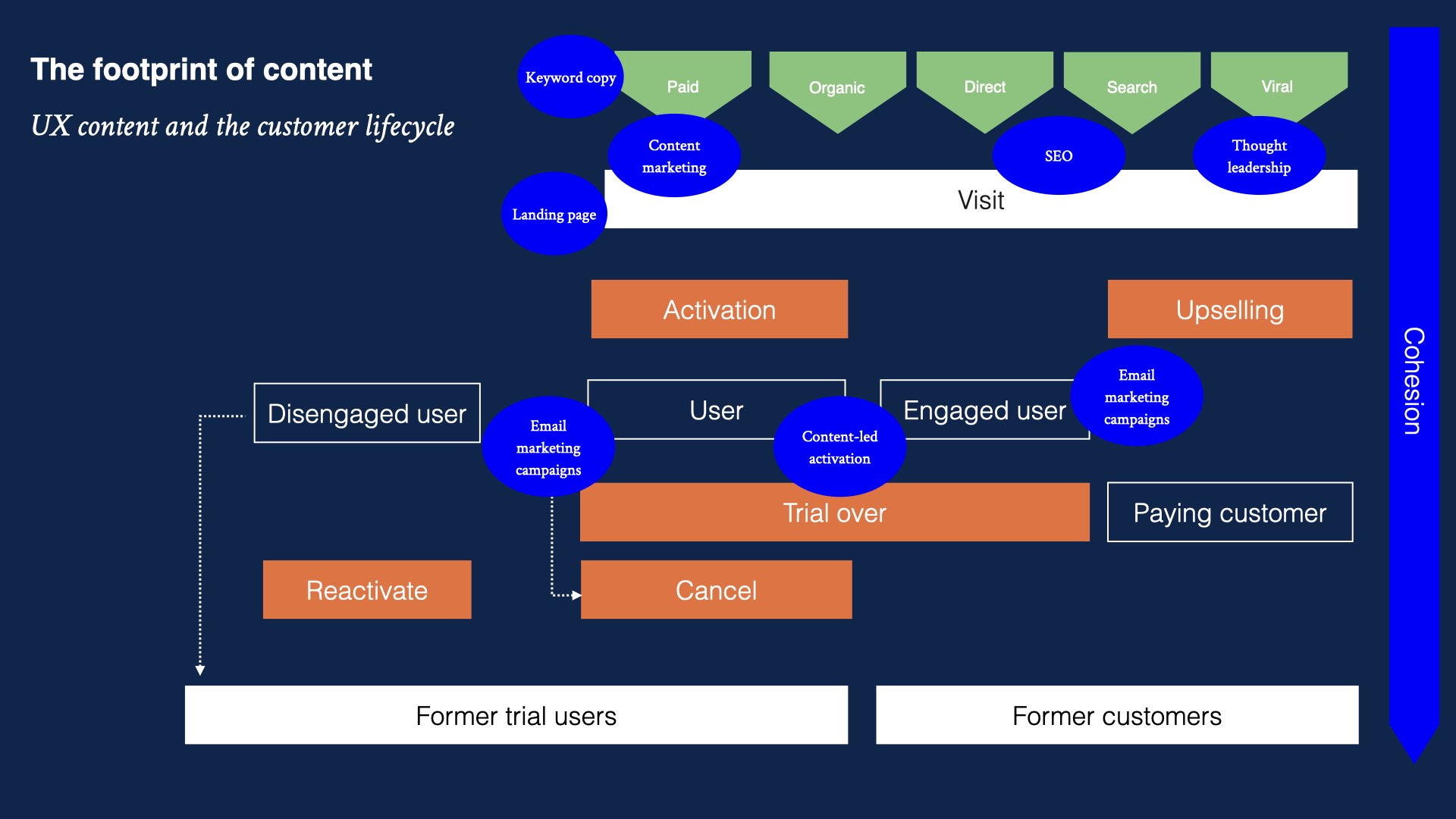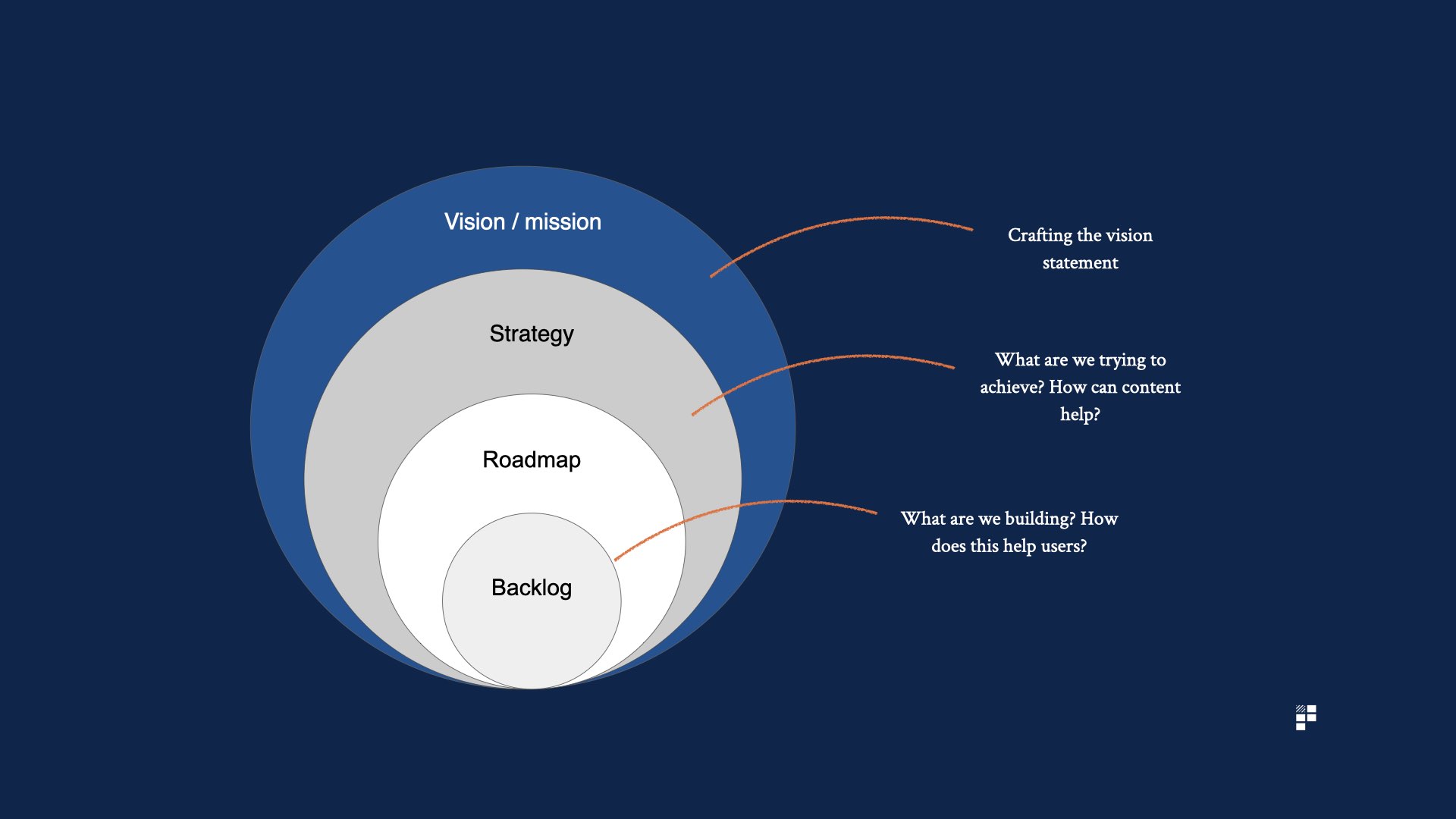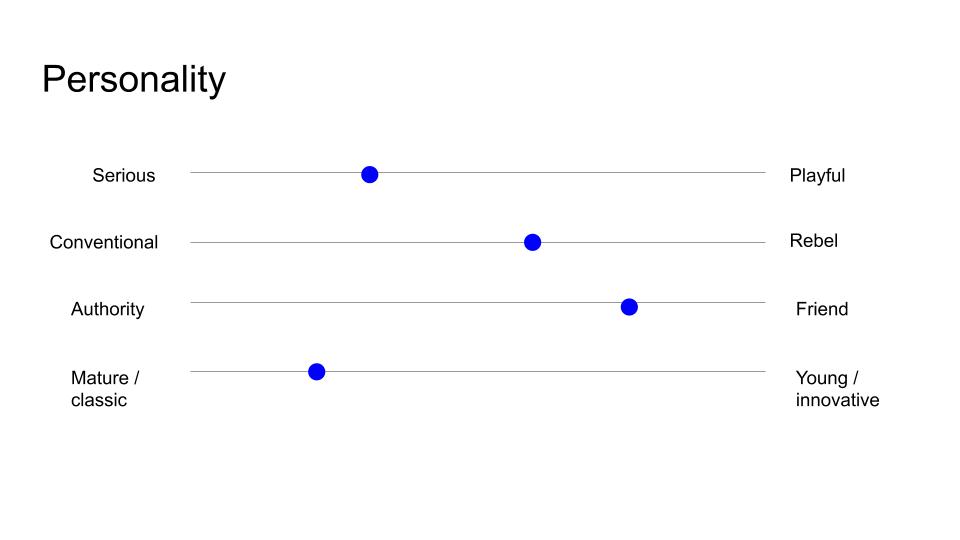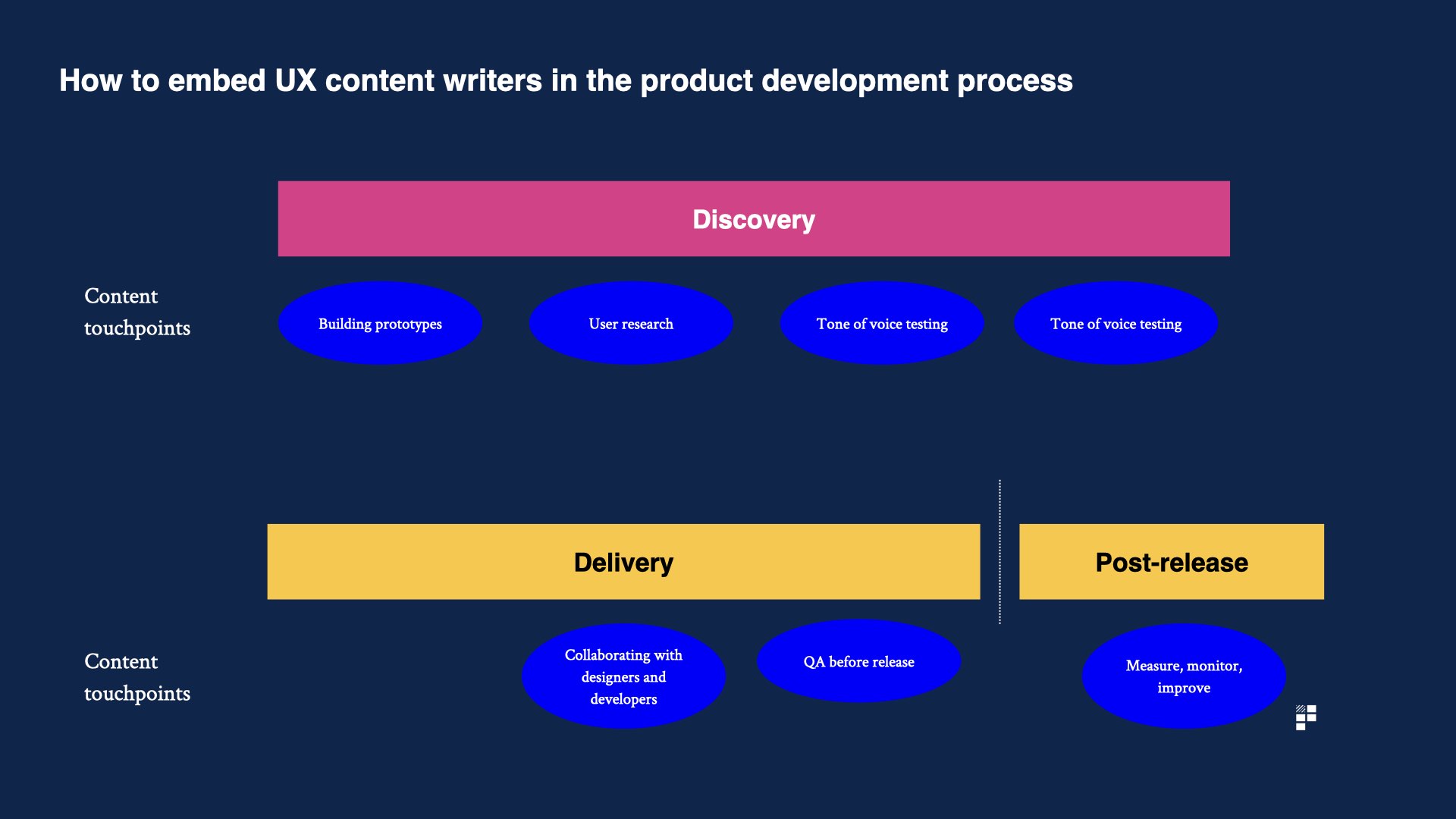How to Create a Product Content Strategy
Why UX content writers are the unsung heroes of the modern product team and what you can do about it
I used a product the other day and it referred to me as the ‘system administrator’. I chuckled a little at the naming but then paused to think. Who actually came up with this name, and how? It’s easy to chortle at the misfortune of such a ridiculous name being given to a user of a product, but then I started to wonder whether I was actually giving content the attention it deserves on the products I was working on at the time. I probably wasn’t.
The awkward place content finds itself in product development
The importance of content is downplayed in the grand scheme of all the complex pieces required to bring products to life. If I had to list the perceived importance of each of the relative disciplines from the lens of a typical stakeholder, the list would probably look a little like this:
- Engineering – ah, code, complex, difficult stuff. I couldn’t do that.
- UI / visual design – ooh this looks nice. I kinda do that already with my Powerpoint presentations but this is a bit nicer.
- Content – writing, words, easy. Anyone can do that.
Harsh, but that’s how it feels to me at least.
Content is perceived as something that can be slapped onto a design at the end of the product development process. But in the best companies, content is the design process, not an afterthought. A product that has invested heavily in integrating content into the overall experience oozes quality. You can feel it.
A software engineer at a fintech startup recently recounted a story of how a simple text change on mobile notifications led to a jump in engagement from 5% to 50%:
The moment I realised the power of "nudges" was at Monzo when we changed the push notification copy on P2P transfers to include "Tap to say thanks!".
Immediately the number of people doing this went from ~5% to around ~50%. One of my favourite features despite its simplicity!
— Kieran McHugh (@kieranmch) July 21, 2020
With talented content UX writers on board:
‘System administrators’ transform simply into admins.
‘Authentication method’ becomes ‘log in safely’.
‘Validation Error! Please try again’ is re-phrased as ‘Please enter an email address’ instead.
Left to their own devices, engineers will write awful copy (that’s not their job, I know) and designers can’t be expected to have the linguistic as well as visual flair to help users achieve their goals.
Talented UX content writers are hard to find. I’m not even sure if that’s what they’re called, but UX content writers are people who are addicted to understanding the psychology of user problems and generating creative, text-based solutions to solve them.
UX content writers possess a unique combination of 3 things:
- UX – understanding user problems and needs
- Writing – being able to write effectively in ways that address user problems and needs
- Context – a wider understanding of how solving this specific issue fits into the wider context of the business’ goals
I’ve only ever had the pleasure of working with a few really strong UX content writers and the addition to a product team can truly transform the overall user experience, and ultimately the business itself.
How product managers and UX content writers can build a solid product content strategy
Developing a product content strategy means product managers, designers and UX content writers working closely together.
Content and the customer lifecycle

If you think about it, content is central to the lifecycle of a customer.
Users may have been acquired through content marketing or social ads. Your onboarding journey will have guided users through successful activation and once activated your product may need a rich set of FAQs / help sections to help troubleshoot users through their needs.
It helps to ensure that the customer experience is as coherent as possible across their lifecycle. Landing on a marketing landing page which uses a completely different vocabulary and tone of voice to the product itself can be jarring and off putting.
As a starting point towards coherency, map out your customer’s lifecycle journey and highlight all the areas where content is heavily influential in driving outcomes.
Here’s a few ways that product managers and UX content writers can work together to build a solid product content strategy.
1. Align and engage with business strategy

If you’re building a new set of APIs to expose to customers, you’ll need solid content documentation.
If you’re aiming to launch a new product in the B2B space your vocabulary may need to alter slightly to cater to a different audience.
What’s the business strategy and what’s the product strategy? What role can content play in helping the product achieve its goals?
These are some critical questions that will need answering. And content writers need to know the answers to these questions if they’re to be able to create a successful content strategy. Product managers and content writers should align on the goals of the product and the business as part of developing a content strategy.
Example 1 – Goal: improve activation rates to 50%
If increasing activation is goal, how might content UX writers help the product team achieve it?
Well, there’s clearly many ways, but let’s consider one example: default empty states. That is, what all your first time users see when they first log into your product. Default empty states are often overlooked by many product teams who are so deep into their product’s power user feature sets that they forget that 90% of users might never get beyond this first state.
Activation is driven by default states.

Facebook’s news feed famously read ‘You have no friends’ for first time users by default. What do your default states say? And how might you craft something which improves your activation rates? That’s the job of a UX writer who knows what they’re doing.
Example 2 – Goal: reduce our customer acquisition cost
One of the most impactful roles that content plays in modern SaaS products is generating revenue and reducing marketing costs at the same time. If the purpose of your content strategy is to get stakeholders excited, reducing the cost of customer acquisition is a powerful way to do it.
3 things to ask yourself when developing your content marketing
- Problems – what problems, if any, does this piece of content solve for our audience? Not all content marketing needs to solve a problem, but solving people’s problems makes them trust and value you more
- Relevancy – will our audience care or are we just talking to ourselves?
- Uniqueness – is what we’re creating unique in any way or are we just regurgitating Google searches? Consider how you might add to the conversation or bring a fresh perspective to an existing topic.
Content marketing as a box checking exercise
MailChimp recently started creating original video documentaries which to me seemed really odd. It feels like checking the ‘content marketing box’ when content is seemingly created for the sake of creating content.
Creating a generic piece of content is easy. Formulating a strategic content plan that aligns with your company’s values and goals is more difficult. Some companies create content just for the sake of it, and you’re left wondering what on earth does this have to do with this company?
If you’re creating generic marketing content for the sake of checking the content marketing box, it might be better to stop and rethink how you might be able to offer content that’s genuinely valuable to your audience.
2. Set a tone of voice

How exactly does a team agree on a tone of voice? What even is a ‘tone of voice’ anyway? It’s difficult, and it always seems a bit wishy washy. Something for the branding and marketing teams to take care of, but not the product team.
Crafting a tone of voice starts with the fundamentals. Trying to decide on a tone of voice is almost impossible if the business as a whole hasn’t decided on its brand values and positioning.
Use your brand positioning and product principles to inform your tone of voice.
Activities that can help you set a tone of voice include:
- Personality spectrums – are we serious or funny?
- People comparisons – if we were a famous person, who would we be?
- Brand comparisons – are we Nike or Reebok?
No single one of these activities will decide on your tone of voice, but using these activities your content team can draw up a series of branding principles and guidelines that inform the language and vocabulary used.
3. Craft content design guidelines and vocabulary
The UK government’s gov.uk is widely admired for its approach to content design. It even offers courses in teaching content design as a discipline to students, demonstrating just how seriously it takes the topic.
All content on gov.uk must meet strict content guidelines before publishing and you can get an idea of the kinds of content guidelines it provides to writers here.
When developing a product content strategy, product teams can borrow from this approach and create their own content design guidelines.
Some things to consider for inclusion in your content guidelines are:
- Formats – how are common formats such as dates and times written?
- Email manners – how do we address our customers in our emails and other comms? Do we sign off with ‘Thanks’ or ‘Cheers’?
- Vocabulary – what language would we use for common terms in our domain?
As with all things product, your content design guidelines can adapt and change organically over time; whilst it’s useful to document and share them, don’t be afraid to revisit them as your strategy evolves.
Vocabulary as a strategic differentiator
When deciding on your vocabulary, it’s useful to cast your eye across the market to see how other players in the market speak. For older, staid industries ripe for innovation, there may be opportunities to differentiate your product using your vocabulary and language.
4. Action
Your product’s content strategy will need to address how exactly you plan to implement some of the strategic decisions you’ve made. This means outlining the process of content creation and the role content plays in the wider team.
Getting the process right – embedding content within the product development process

Where exactly should the creation of UX content sit within the product development process? It helps to involve UX content writers from the outset, rather than trying to shoehorn content onto designs later on.
Why?
- Explaining the same things multiple times to different people in the team is laborious
- Bringing people along the same journey as other team members means they understand the deeper context of what might lead to certain solutions
- Understand a problem deeply is easier when you’ve been involved during the beginning
And what does ‘involving’ content writers actually mean? It means activities that include:
- Talking to customers to understand their problems. This is particularly helpful in a SaaS context where understanding niche domains is critical.
- Whiteboarding concepts together with your designers.
- Testing prototypes with users and watching user feedback in real time.
Measuring the effectiveness of UX content strategies
Finally, after you’ve gone through the effort of working closely with your colleagues in content to craft a product content strategy, you’ll need to figure out how best to measure its effectiveness.
The metrics you use to measure the effectiveness of your content strategy will be based on the areas you decided to focus on and the goals you set yourself.
If improving activation was the goal, what’s happened to the activation rate?
If reducing CAC was the goal, how’s your CAC looking?
If crafting a product that oozes quality was the goal, how are your LTVs and app store ratings looking?
Armed with the results of your strategy, tell the story of how content played a role in achieving your goals. The unsung heroes of the modern product team will thank you for it.



